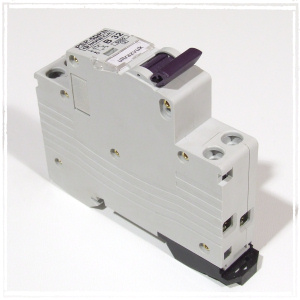The same safety as for 1P+N



1. Extraordinary High-Speed Break
The sooner is the entire short-circuit
process terminated, the lower is the damage of connected devices and wiring.
An extraordinary high breaking rate from the moment of a short-circuit
arising up to its termination amounts to max. 10 ms (with a maximum loading). Other producers usually vary within
the values which
are at least 2 – 5 times higher.
The BONEGA® P-E-P DPN's do not reach that high rate to the detriment of the
higher arc voltage which raises the risk of protected parts (e.g. motors)
considerably. As compared to other DPN's, the arc voltage is equal or lower.
The high-speed switch-off consists of three stages:
- stage 1 – disconnection of contacts
- stage 2 – arc running into the chamber
- stage 3 – arc burning termination
The principal advantage of our DPN´s consists of an extraordinary high speed
within the first two stages. The third stage is very quick, as well, but it is
not so essential in the framework of the total speed. Within this last stage, it
is most essential that the chamber is so well constructed that the arc does not
“jump-out” in any direction (especially it does not come back to the contacts at
all).
An almost textbook run of the short-circuit process is caused also by the
suitable adjustment of the contact thrust. These contacts do not deviate by
the influence of aerodynamic forces (as obvious from the
charts).
Note: Some producers mention only the speed of contact disconnection (which is
the first stage) instead of the total breaking speed. In the moment of contact
disconnection, the power is still flowing through the circuit (voltage and
current) because of the created arc. In this stage, the DPN has not disconnected
the circuit yet.
Conclusion:
- Our curve of breaking procedure is fully unique (an example how a DPN should protect).
- The extremely
high breaking rate will not endanger the end user, but – in contrast – it
will protect him better
- The extraordinary breaking rate of the BONEGA® P-E-P DPN's provides the
most sensitive protection
of human lives, electrical devices within a circuit, and wiring itself.
A significant advantage of our DPNs consists in an
extraordinary high speed during the first two stages. The third stage is also
very fast in our case, but it is not so significant for the entire speed. Within
this last stage, it is more significant the fact that the chamber is so exact
that the arc does not “jump out” the chamber in any direction (especially, it
does not return onto the contacts at all).
 top
top
2. HIGH BREAKING CAPACITY (SHORT-CIRCUIT RESISTANCE)
The BONEGA® DPNs can be used even under the most demanding short-circuit
conditions.
Our primacy consists in the breaking capacity of 6 kA up to the
highest value of 32A, even with the curve “C” pursuant to CSN EN 60898. The
hitherto highest reached breaking capacity for DPN does not exceed 4,5 kA.
Our world-wide uniqueness consists in integration of all following
phenomena with the kept breaking capacity of 6 kA:
I.) It is necessary to be aware of that the inside DPN´s resistance affects –
among others – the breaking capacity. With the low nominal values (e.g. 1A),
almost every producer can pride himself that his DPN theoretically has an
unlimited breaking capacity. The higher is the nominal current, the lower is
the assistance of the inside DPN´s resistance to absorb the short-circuit
process. The nominal current crucial value lies at 25 A DPNs and the very
critical one is at the highest value, i.e. 32A within the characteristic curve
“C”. If the experts want to detect the DPN´s quality, so they always use the
aforementioned crucial values (25 A and 32 A). Within these values, the design
of the breaking mechanism, contacts, extinguishing chamber etc. becomes known
very clearly.
The essential difference, as compared to the DPNs of several producers,
consists in the reached range of nominal currents, which is reached with the
mentioned breaking capacity (6 kA, 4,5 kA, 3 kA, ...). We are preparing the
upper limit of the nominal currents, which can our DPNs reach within the
breaking capacities exceeding 6 kA.
II.) Another important difference consists in the reached standard, in
accordance with which the producer has achieved his certification. In Europe,
there are two basic standards, namely:
a) the so-called „industrial“ standard CSN EN 60947
b) the so-called “household” standard CSN EN 60898
As to their relations to breaking capacities, the standards differ e.g. in their
requirements of short-circuit quantity, which a DPN has to withstand without
disablement of its function. That means one short circuit pursuant to the
standard ČSN EN 60947 and three successive short-circuits pursuant to the
standard ČSN EN 60898.
As resulting from the above, the industrial standard is significantly softer.
For many people, that requirement of the standard seems to be illogical, but is
takes into consideration the behavior of a user, after the circuit has been
broken by a DPN. The reaction of the user in a household often is that he tries
to switch-on the DPN for the first, second and third time and just after that he
begins to trace the cause. In contrary, a professional electrician tries to
switch-on it only once and if the DPN breaks again, he begins to trace the cause
immediately.
Thus notice at other producers, according to which standard and up to which
nominal current values they mention the breaking capacity. You can be surprised
even by the results of worldwide-accredited producers.
The above parameters are reached thanks to the distinguishing chamber that is
one of our two worldwide-acknowledged Czech patents within the DPN range. It
concerns its extraordinary property when its width could be just 6 mm.
 top
top
3. Reduction of Undesirable Power During a Short-Circuit
The lower the power within a
short-circuit,
the less damage to the connected devices and wiring.
It is a very important property of a DPN, which is often marginalized by the
public.
The protection quality by a DPN is also conditioned by the amount of power
that “flows” through the device during a short-circuit. Its amount is given by
the relation: E = I2.t. As resulting from the mentioned relation, the high
breaking rate of a DPN reduces even that spurious power.
The standard CSN 60898+A1/A11 states the power limits based of which the
individual categories are assigned to the protective devices. The category
(class) is mentioned on a DPN in the frame below the breaking capacity.
Our DPNs reach the limits of the 3rd (the highest possible) class without
power limitation pursuant to CSN 60898+A1/A11, namely even with the nominal
breaking capacity of 6 kA.
The following tables show the requirements of the standard for the protective
elements up to 16A and above 16A up to 32A incl., at various nominal
short-circuit capacities.
| PERMITTED I2T VALUES PURSUANT TO CSN 60898+A1/A11 FOR DPN
WITH NOMINAL CURRENT UP TO 16 A INCLUDING |
| Nominal short-circuit capacity
(A) |
POWER LIMITATION CLASSES
|
|
1
|
2
|
3
|
|
max. I2t
A2s
|
max. I2t
A2s
|
max. I2t
A2s
|
|
type B a type C
|
type B
|
type C |
type B
|
type C |
| 3 000 |
the limits not stated
|
31 000 |
37 000 |
15 000 |
18 000 |
| 4 500 |
60 000 |
75 000 |
25 000 |
30 000 |
| 6 000 |
100 000 |
120 000 |
35 000 |
42 000 |
|
(the values written in bold digits are valid for our DPN
BONEGA®, P-E-P series ):
|
| PERMITTED I2T VALUES PURSUANT TO CSN 60898+A1/A11 FOR DPN
WITH NOMINAL CURRENT EXCEEDING 16 A UP TO 32 A INCL. |
| Nominal short-circuit capacity
(A) |
POWER LIMITATION CLASSES
|
|
1
|
2
|
3
|
|
max. I2t
A2s
|
max. I2t
A2s
|
max. I2t
A2s
|
|
type B a type C
|
type B
|
type C |
type B
|
type C |
| 3 000 |
the limits not stated
|
40 000 |
50 000 |
18 000 |
22 000 |
| 4 500 |
80 000 |
100 000 |
32 000 |
39 000 |
| 6 000 |
130 000 |
160 000 |
45 000 |
55 000 |
|
(the values written in bold digits are valid for our DPN
BONEGA®, P-E-P series ):
|
 top
top
4. DPN-LOCKING PROTECTION
The DPNs BONEGA® P-E-P cannot be locked
from outside.
|

On -red I - ON
OFF - green O - OFF
|
As one of few DPNs, the DPNs BONEGA®have an indication of the
contact condition. That indicates a real contact condition and not only a
position of the switch-on lever. In case of “sintered” contacts and switched-off
lever, the user is clearly informed about flowing current. As the only ones, our
DPNs have that indication covered with a transparent plastic sight-glass
with a lens (magnifying) effect.
|
Reasons:
- Because the indication is closely connected with a movable contact, it
happens on other DPNs that the movable contact can be locked through the
indication by means of a toothpick or a matchstick; thus the complete thermal
and short-circuit protection of a DPN is out of its function. It is not
possible to do this on the DPN BONEGA, just because of that transparent
sight-glass
- Dust protection
This property protects the electro installation companies against claims,
which are really caused by an end user, who can be proved wrong with
difficulties.
5.WORLD-WIDE UNIQUE EXTINGUISHING CHAMBER
The extinguishing chamber affects the
breaking rate and breaking capacity essentially.
The extinguishing chamber is of a fully new patent-protected conception that
allows:
- a very fast “drawing-in” of an arisen electric arc into the chamber
When the movable contact is disconnected from the fixed one, it is necessary
to “draw-in” the arisen arc into the extinguishing chamber as soon as possible
and to interrupt the circuit definitely. Our DPNs do not reach that high rate
to the detriment of the higher arc voltage that increases the risk of
protected parts (e.g. motors) considerably. This could be reached e.g. by
higher number of sheets at the extinguishing chamber. Our chamber has only the
usual 13 interruptions. As compared to other DPNs, the arc voltage within the
DPNs BONEGA® P-E-P is equal or rather lower.
- it is not possible the arc to return to the contacts
In other DPNs, the arc can return to the contacts, so the circuit is connected
again. Thanks to the design of the chamber, this phenomenon is not possible in
the DPNs BONEGA.
- fast arc extinction
The sooner the arc is extinguished, the smaller amount of heat arises. This
heat can affect the adjacent circuits (warming of an adjacent device etc.)
- utilization of cold air at the extinguishing chamber for cooling the
contacts
At the beginning of a short-circuit process, the non-warmed air inside the
chamber is used for cooling the contacts immediately before they are
disconnected
6. Durability
The characteristic curve of a DPN can be
changed neither by a falling-down, nor by a shock.
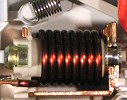
|
The electromagnetic speed ejecting-cage release for protection against a
short-circuit has been designed not to have any adjustable element. The
characteristic curve of a DPN “B” or “C”) is given by the selection of the
coil copper-wire’s diameter, the number of threads and the spring bias
voltage in the coil core. This design excludes the possibility our DPNs to
change the given characteristic curve by a falling-down or a shock in any
way.
 top top
|
7. Vibration Resistance
The DPN BONEGA®can be used within the
equipments with strong vibrations (e.g. railway wagons, site switchboards).
At other DPNs, strong vibrations can cause the short-circuit release to be
put out of service (it loses its protective function) or the spot-welds to be
disconnected (current interruption).
a) measures avoiding the short-circuit release to be put out of service
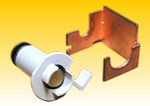
|
The DPNs BONEGA®are protected against the above phenomenon by a suitable
seating of the structure elements, especially of the ejecting coil which is
seated in a unique “cradle” (see the Fig.). This design has excluded the
possibility to misalign and consequently to seize the movable core at the
coil. |
b) measure avoiding the spot welds to be disconnected
The quantity of spot-welds has simply been reduced significantly. The
elements are interconnected by means of a modular design, or the parts are made
of one piece.
8. Higher Safety Standards
The casing design protects against an
injury by current when being touched by a finger.



By a suitable casing design, all the terminals are protected against a finger
touch or penetration of strange small objects (it complies with the
protection IP 20).
9.WIDE SELECTIVITY
A DPN can be used even within more
complicated projects.
A wide scale of current values and characteristic curves B and C enables our
DPN´s to be put together to various safety cascades. Because of the above, the
desired selectivity can be reached. The selectivity means a coordination of two
successive breaking devices so that just the disabled wiring part can be
switch-off upon a failure.
 top
top
10.COLORED AND BLACK CONTROL LEVERS
The colored levers increase the clear
arrangement and comply with the requirements of power-supplying plants.
We supply both the color version pursuant to the values of nominal currents
(which correspond to the indication of cap fuses) as a standard, and the black
version upon requirement.
|
6 A |
Green |
|
|
10 A |
Red |
|
|
13 A |
Sand |
|
|
|
16 A |
Grey |
|
|
20 A |
Blue |
|
|
25 A |
Yellow |
|
|
32 A |
Violet |
|
|
11. THE POSSIBILITY TO SEAL THE LEVER IN THE ON OR OFF
POSITIONS
The possibility to seal it for special
purposes.
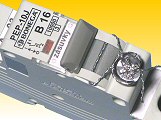
|
The lever can be sealed because of openings in both guiding sidewalls of the
switch-off lever. Through these openings, a sealing wire can be fed. This
sealing wire passes also through a groove on the movable lever.
This groove has been engraved in OFF and ON positions and it disables the
motion of the lever itself.
If the lever is sealed in the ON position, the immobility does not render
the function of the DPN. In the event of a short-circuit or an overload the
circuit will be shut-down (independently on the fixed position of the lever
and without any restrictions)
The DPN casing enables the lever to be sealed without any influence onto
the location of the adjacent devices.
|
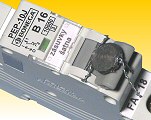
 top top
|
Export Manager: Michal Hudeček, tel: +420 605 518 724,
[email protected]
Sales Department: - Mrs Adriana Jamná,
fax +420 518 335 216, email : [email protected],
696 66 Sudoměřice nad Moravou 302
